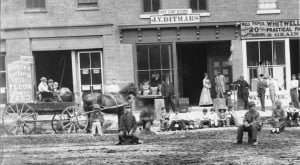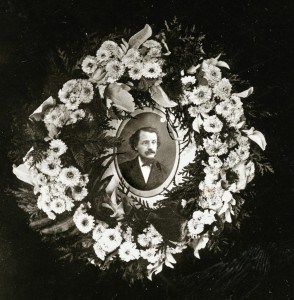Diphtheria Epidemic
By Anne Dealy, Director of Education and Public Information
Diphtheria prevails to no little extent in Geneva, although there have been but few fatal cases.

The window in St. Peter’s Episcopal Church tower dedicated to the ten members of the Sunday School class who died in the diphtheria epidemic.
This brief notice in the October 4, 1878 Geneva Gazette marks the first mention of what would come to be one of the worst epidemics in the community’s history. By April 1879 at least 75 people, mostly children, lost their lives. Over 400 of the village’s residents fell ill with the disease between September 1878 and March 1879. Whole families became sick, and a few parents lost all of their children to the disease. Some people had relatively mild cases, but others had the particularly frightening “membraneous” type, in which a thick gray substance formed over the throat causing the victim to gasp and choke when breathing.
Most Americans today have no experience with this disease, which has been largely eliminated in the west due to vaccination. Symptoms include a sore throat, fever, chills and swollen glands. The illness itself is not deadly, but the diphtheria bacteria can produce a deadly toxin that causes heart damage, nerve damage, paralysis, and lung infection. It is one of many ailments that is particularly devastating to children, but can kill anyone, even those who have had it before.
Aside from dealing with the fear that normally accompanies a disease epidemic, Genevans in 1878 also had no understanding of the cause of diphtheria, nor any real defense against it. The scientific revolution in medicine was just beginning in Europe, and medicine was not yet synonymous with science. Particularly in the United States, there were almost no standards for medical education, nor were there standards for diagnosing disease. Any sore throat could be labeled diphtheria, particularly by an inexperienced doctor. Doctors were free to follow any treatments they believed worked, and they relied on personal observation and experience, rather than evidence, to diagnose and treat illness. As a result, theories of disease causation and treatment varied from the reasonable to the ridiculous.

Some believed open drains, dirt roads and streets strewn with manure caused the 1878 diphtheria epidemic. Castle Street, c. 1870s.
One popular theory circulating in the late 19th-century posited that sewage and filth caused disease. “Filth” could refer to human and animal excrement, trash, swampy land, or rotting plant or vegetable matter. Recognition that water supplies were connected to the spread of diseases like typhoid and cholera led people to conclude that many other ailments resulted from water and air contaminants. One headline in the Geneva Gazette during the epidemic read “Malarial Disease and Its Remedy.” The article went on to decry that “Geneva is deplorably defective in sewerage. Without it many people have been accustomed to drain into several little open streams which have their outlets into the lake and canal.” The newspapers were full of letters and editorials on the danger of open drains and piles of dead leaves, and the need for a sanitary sewer and safe water system. A sewer system might have prevented waterborne diseases, but would have done nothing to stop the spread of diphtheria, which is transmitted by airborne secretions or contaminated items, like utensils or clothing.

The boards leading from South Main Street’s sidewalks allowed pedestrians to step over the filth in the gutters.
There was some recognition that the disease could be passed from one person to another, but there was no quarantine in effect. By late October, the village Board of Health made several regulations to try to control the spread of the disease, declaring that “The body of every person who has died of diphtheria or scarlet fever, shall be immediately enclosed in an air-tight coffin…” and “No person shall enter any house where there is a case of diphtheria or scarlet fever, unless invited for the purpose of assistance…and no visit shall be made after death…” It did not help that many victims had mild infections, and people assumed the mild form was not as communicable as the “malignant” form. In all likelihood, this difference in severity was not due to the infection itself, but whether or not the diphtheria bacteria had produced its deadly toxin.
Druggist E. Maynard in a mid-November article advocated “the unceasing use of disinfectants in the sick-room and in every room adjoining, and every vessel, slop-jar, etc., etc. that shall contain any secretion of the sick.” He went on to recommend burying all clothing or bed clothes that came in contact with discharges from the patient’s mouth and washing clothes in carbolic acid. These precautions probably did help prevent transmission of the disease. On the other hand, the next article advocated gargling with kerosene oil as a cure. Many people recognized their helplessness in the face of this disease, “confess[ing] that when [diphtheria] advances to a certain stage, poisoning the blood in the arteries and veins, a cure is impossible.”
Among the dead were dry goods merchant George Seelye and his only two children. His wife survived. Civil War veteran Dr. Calvin H. Carpenter, while treating patients with the disease, watched it take his own 11-year old son before he himself fell ill. The doctor’s brother then died of it. Three other village doctors also saw their children die. African-American Charles Gates lost his 6-year old daughter Lena May. Machinist Mathew Easterbrook died at 54 years old. Several students fell ill and the college closed for two weeks. One went home to die there. A sales agent for the Geneva Courier who had just moved from Bellona fled back there with his children, only to watch them both die.
Then in December new cases slowed. From 10-15 deaths a week, losses fell to two or three, then one or two a month. People had no explanation and turned to religion for consolation. Said one mother, “I was distracted when my Bessie went but now I am calm. Bessie and Gracie are together, and safe, safe from every danger.”
The village began to examine the cost and methods of creating a sanitary water and sewer system, but the cost was high and many did not think it worthwhile. Over the next decade village voters rejected plans to fund a sewer system multiple times. The community continued to use Castle Creek as an open drain and deposited sewage in Seneca Lake. It would be more than twenty years until the city created a sewer system—about the same time the diphtheria bacteria was identified and an anti-toxin and vaccine were developed, finally preventing the countless deaths caused by the disease.
For more information
How Horses Helped Cure Diphtheria



My Great Grandfather, graduate of UVM in 1901 , told me a story of a little boy with this dreaded desease. As a new young doctor, he was called to the house of the child. Dr. Frank Lewis, went and got a bendable stick, put mounds of some type of gauze and put this all the way down the chld’s throat. He said the mucus was black, but after many times and several days, the little fellow lived.This all took place in Isle La Motte, Vt.
I came across this article because I was curious to know if kerosene was ever used to treat diphtheria during the early 1920’s. Here is why…
Me My father told me that as a boy, he almost died from diphtheria had it not been for his father who “poured kerosene” down his throat. My father said he was unable to breath any longer and his father quickly did this to revive him. According to my father, he felt his throat “on fire” and began coughing and this is what saved his life.
There were many cures recommended for diseases like diphtheria and consumption that were hazardous to the patient, whether bleeding, emetics or kerosene. A look at Google books shows that even in the 1890s, this was not a recommended treatment. Apparently it emerged from uninformed ideas about germ theory. Sadly, the internet has continued to spread the idea that kerosene can be used to kill germs. It will kill germs, but it’s also toxic to the cells in your body, so it’s not a very good cure. The kerosene may have worked in your father’s case as any substance would have that removed the blockage or stimulated fierce coughing. He may have been likely to recover anyway, but the membrane was blocking his airway. I am not a doctor though, so I really don’t know!
Very interesting and well-written.
With so much bad news, we sometimes forgot how much better many things are today.